Located on the eastern side of Quito, Pichincha volcano, known in Spanish as Rucu Pichincha, offers an incredible day hike which should be included in all good Ecuador itineraries. The volcano is a whopping 4,784 metres above sea level (15,695ft) which makes for a fantastic trek and some stunning views.
The trail begins at Cruz Loma which sits at the top of the TeleferiQo, South America’s highest gondola. Although hiking Pichincha volcano is highly recommended (assuming the weather conditions are good – more on this later), it is definitely worth taking the trip up the TeleferiQo for the views alone, even if you do not intend to tackle the hike. There is a swing at the top as well as a restaurant which serves local cuisine so you could always make a morning of it!
On a clear day, you will be able to take in the sights of some of Ecuador’s most impressive volcanoes, including the famous Cotopaxi, which was the catalyst for the famous Mama Negra celebrations which take place in Latacunga.
This post contains affiliate links. If you use them, I will receive a small commission at no extra cost to you.
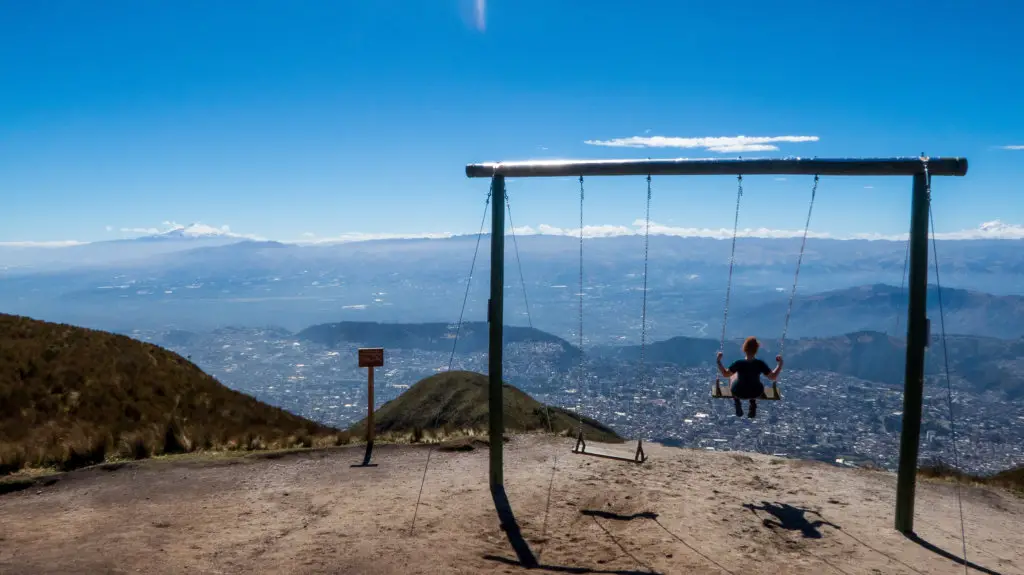
Everything You Need to Know About Hiking Rucu Pichincha
How do I get to Pichincha volcano?
To reach Cruz Loma, the starting point for the Rucu Pichincha hike, you must take the TeleferiQo to the top. The TeleferiQo opens at 9 am and closes at 8 pm. The journey up the gondola takes around twenty minutes and costs $8.50USD for foreigners. Locals pay a reduced rate ($4.50USD).
The TeleferiQo is located close to the VulQano amusement park. Owing to the location of the gondola, travellers are advised to travel to the TeleferiQo by taxi. Quito is not a dangerous city per se but still one where tourists and travellers should take precautions.
A taxi from Mariscal or the Old City will cost around $5USD. It is always advised that you ask your accommodation provider to call you a taxi rather than hailing one directly on the street.
When can I hike volcano Pichincha?
The dry seasons (June – August and December – February) are the best times to attempt this hike. Avoid setting off after 11 am as cloud usually rolls in during the afternoon which can affect visibility.
Trail conditions
Upon arriving at the top of the TeleferiQo, a sign will direct you to the beginning of the trail. Initially, the route is easy to follow as the vegetation has already been beaten down by the footsteps of hundreds of other hikers. However, as the trail goes on, it can be harder to distinguish which way is the right way. Make sure you have checked the route details on maps.me beforehand and hire a guide if you are unsure of the route.
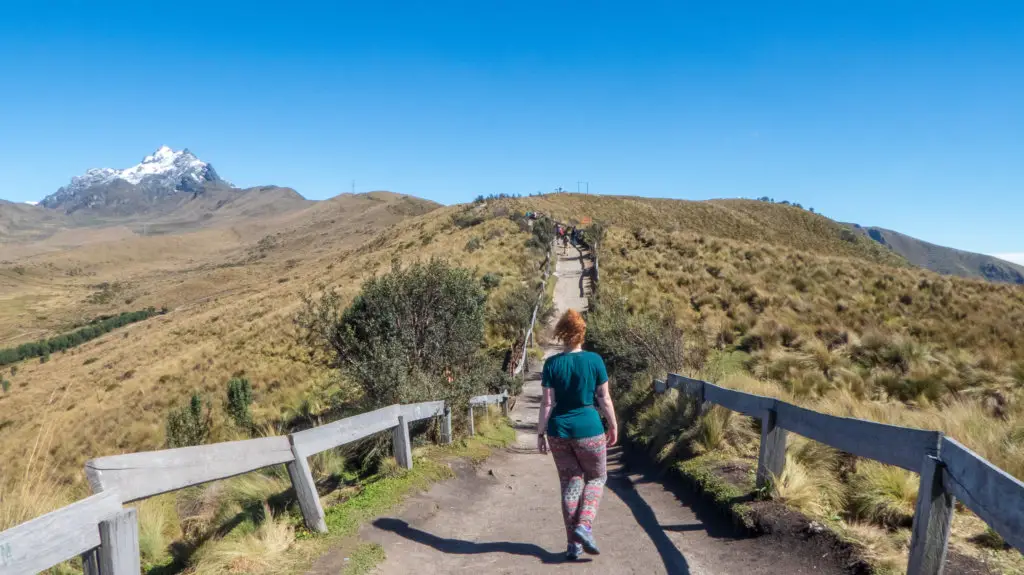
Hikers should be prepared for a short climb over some rocks and some thin sections of mountainside trail. Rain and mist is common at this altitude so you should be very careful as the rocks are often slippery. For those afraid of heights, it is worth mentioning that parts of the hike give way to a steep drop. Snow is uncommon on the trail but it does still settle here on occasion, making hiking challenging.
Is hiking Pichincha volcano safe?
In my honest opinion, the trail up to the top of Rucu Pichincha can be dangerous. In bad weather, the route is treacherous and visibility is bad. Although hikers should always check the weather forecast, it is not always easy to predict as changes at this kind of altitude can happen very quickly.
The trail itself has a bad reputation for theft, with thieves deliberately targeting solo hikers. Whilst I never met anyone who had issues on the trek during my time in Quito, I would still recommend hiking in a group just to be safe.
Although there are risks with taking on Pichincha volcano, the hike can be pleasant and offers stunning views. If you are in any way concerned about your ability to hike the volcano, I would wholeheartedly recommend hiring a guide.
Where can I hire a guide?
Many tour agencies offer guides for the Pichincha hike and most of them operate in the ‘New’ area of Quito. Prices usually vary depending on whether transport is included and the number of people in the group.
Mountain guide Edgar comes highly recommended for this hike. Contact him and plan your Pichincha trek using his website.
What should I wear on my Pichincha volcano hike?
- Quick dry t-shirt
- Light fleece
- Waterproof jacket / hiking poncho
- Sports leggings or hiking trousers
- Merino wool socks
- Sturdy hiking boots
- Woolly hat
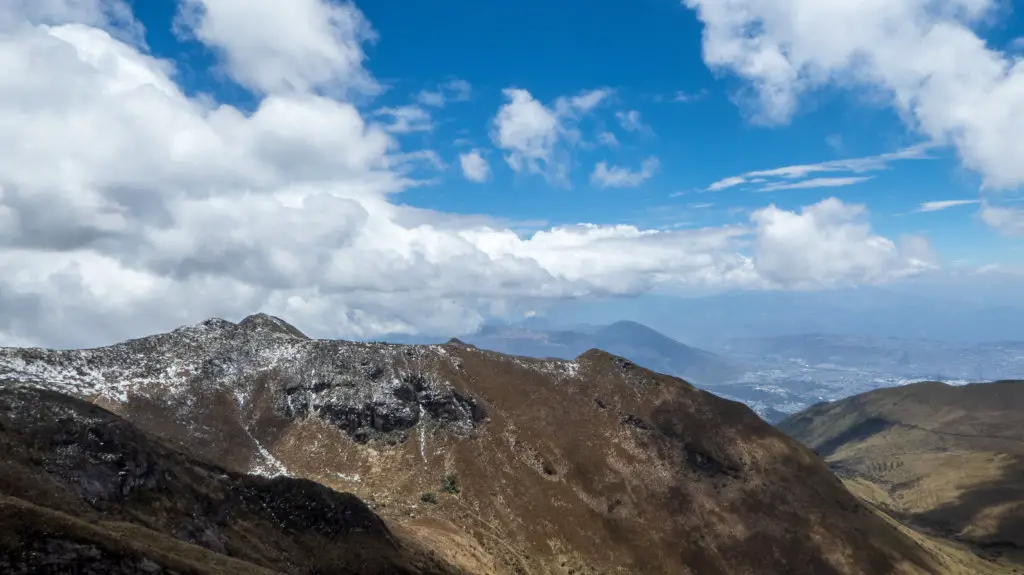
What should I bring?
- Suncream
- Plenty of water
- Snacks
- Sunglasses
- Hiking poles
- Daypack
How can I prepare for the hike up Rucu Pichincha?
Being the safety nut that I am, I did a lot of research before deciding to take on Pichincha volcano.
Although Tim was sure ‘it would be fine,’ I rarely do anything without checking out the probability of dying. (Something I would wholeheartedly encourage other travellers to do as well.)
The advice about hiking Rucu Pichincha:
- Begin the hike before 11 am.
- Allow yourself a couple of days in Quito to acclimatise before attempting the hike.
- Bring lots of water and food.
- Don’t hike alone.
- Wear layers as it can get cold.
And, that is everything you need to prepare you. Apparently.
Additional advice based on my experience:
- Spend 5-7 days in Quito before attempting the hike.
- Check the forecast and only attempt the hike in good weather.
- Bring hiking poles if you have them.
- Be aware that there is a small amount of climbing required.
- Invest in a trekking guide if you are inexperienced, scared of heights, unsure of the route or just a bit useless.
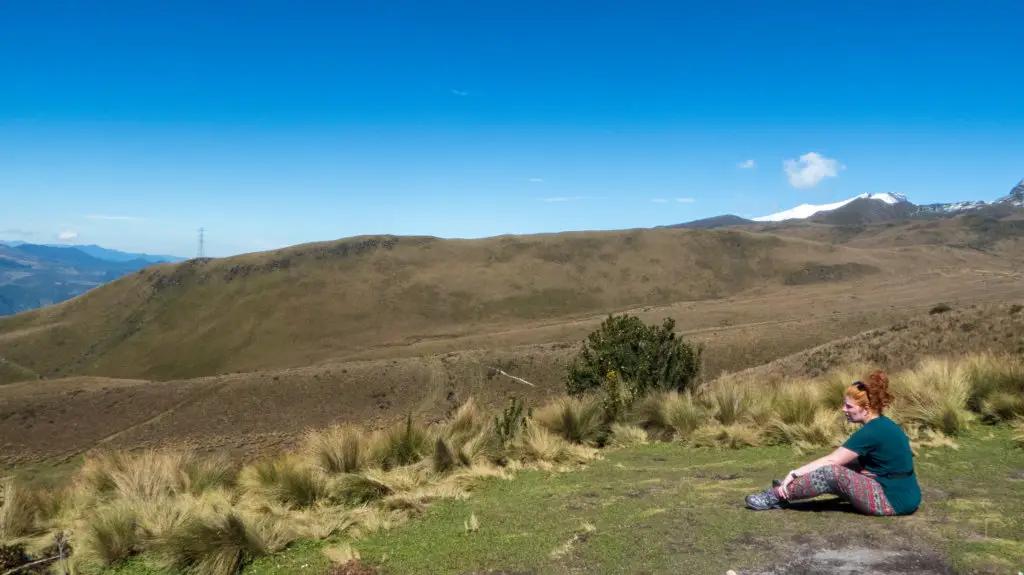
What should I expect from hiking Rucu Pichincha?
The reality of hiking Pichincha volcano…
Upon taking the TelefériQo cable car, Tim and I disembarked at nearly 4000 m above sea level. As we located the trail up to the volcano, we looked down on Quito in awe. It had been reduced to a toy town below us, overlooked by Cotopaxi volcano in the distance.
A sobering reminder of the altitude
As the switchbacks came into view, I strolled confidently over to the bottom of the trail. My confidence lasted all of twenty seconds, along with my breath. After only a few steps, my chest was heaving as I struggled for air. Having read that the altitude would be pretty intense, we had waited not just the recommended two days but nearly a whole week to get acclimatised! Fat use that was though, after only a few metres I needed to stop and take a rest.
I felt like an obese slug who had eaten nothing but McDonald’s for a year (but without the taste satisfaction). Hiking at an altitude really is a whole new challenge. The closest I can get to describing it is by asking you to imagine your whole body has been pummelled by some kind of aggressive flu which leaves your head pounding, stomach churning and muscles cramping. As if that isn’t bad enough, now picture trying to walk up a volcano feeling like this.
Despite being someone who usually hugely enjoys walking, it was fair to say that the altitude had ruined this experience for me already. My jaw kept locking which made me look like I’d ingested some kind of illegal substance and my face was tinged green by the threat of vomit. I also felt crap because I couldn’t keep pace with the other hikers, even the ones who were significantly older than me. I wasn’t sure what all the rave reviews I read were about but surely it wasn’t the hike I was doing – I was not having fun at all.
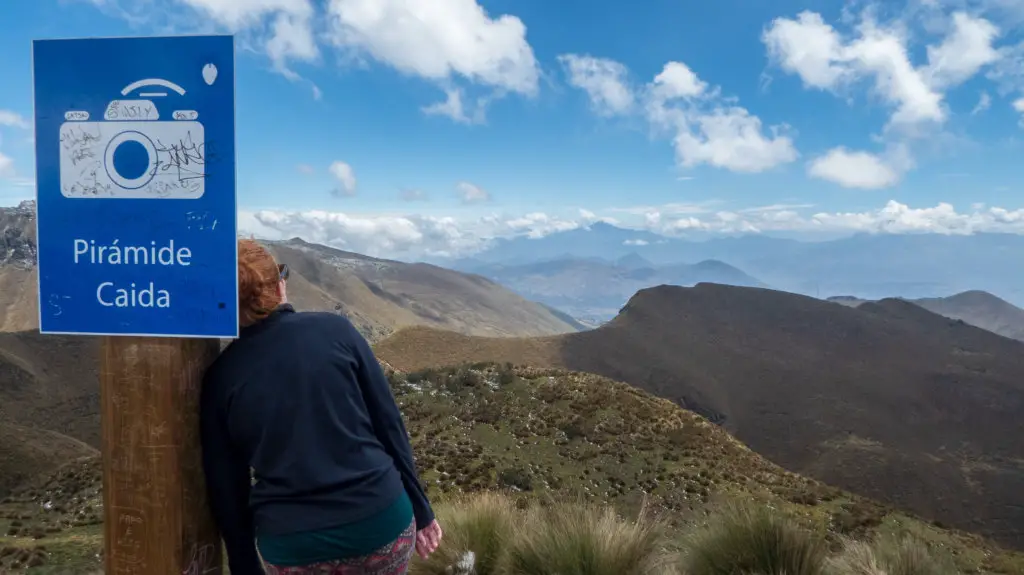
Time to climb!
I continued on and now that I was high enough to see snow, my confidence in the hike resurfaced. I was sure I was going to be able to do it until I was met with bare rock face looming over me. This was no longer a hike, it was a climb. I looked up at the unrelenting barrier before me. People were turning back.
‘What do you think?’, said Tim.
‘I’m not bloody Bear Grylls!’ I replied.
As I began to turn around, a group approached us, led by a guide. The guide quickly ascended the rock with minimal exertion and before I knew it, peer pressure had led me to follow in his handholds. The great British awkwardness strikes again. As my fellow hikers helped heave me over the top, (I shouldn’t have had that extra empanada for breakfast), I flopped down into a puddle of snow. Glamorous I was not but I had made it!
On my nerves edge
After this barrier, it looked like we were well on the way to the summit. That was until we turned a corner to see the narrow ledge stretched out in front of us. It looked tight but easy enough… Quickly the trail turned into jagged rock face. Shit. More expletives rushed through my head as I imagined my Mum’s reaction as she received a call from an Ecuadorian hospital.
Who had said this was a good idea? There was at least a couple of hundred feet to fall and no cushioned landing at the bottom. I felt my knees begin to shake as the panic set in. I continued to move slowly along the side of the volcano, trying to avoid the sludgy remnants of snow that consumed the path. My foot slipped but luckily I managed to regain my balance.
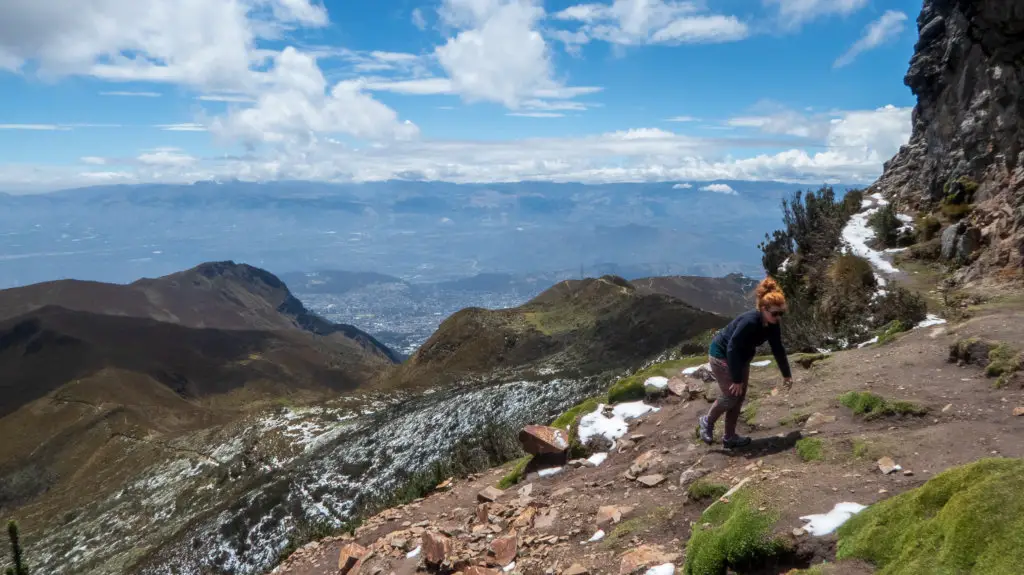
As I stood plastered against the rock hyperventilating, I vowed to be brave. However, as I made my way along the slippery ledge, I realised I could no longer control the direction of my feet. The combination of my erratic movement and the ugly expression on my terror-stricken face left me looking more like a demented puppet than an experienced hiker. I felt the blood start to leave my head as my legs nearly gave way. I stood clutching the edge, desperately trying to avoid a full-on breakdown as tears pricked the corners of my eyes.
I knew that Tim wanted to keep going but my body had completely closed down all of my motor functions. I was in full blown trauma mode and was just about ready to throw myself off the side of the volcano and end it all.
Clearly seeing my distress, some of my fellow hikers helped me to turn my jelly legs around just as the grey clouds began to roll in. Having accepted defeat, I felt much calmer until I heard a crack of thunder behind me. We were now in a race back with the storm!
Running from the storm
Crumbling under the pressure and desperate to end my nightmare, I hurriedly descended down the vertical cliff and lost my footing. Before I knew what was happening, I was rapidly sliding down the rock face and straight toward a sheer drop. All of the pizzas I would never get to eat flashed before my eyes. Out of nowhere, a Norwegian guy caught me before gravity had a real chance to take over. I all but collapsed in his arms, panting heavily and thanking my lucky stars that I had been spared (until Tim’s next death-defying idea at least).
With the hairy bits of the trek now behind us, Tim and I took some time to learn more about the Norwegian who had rushed to my aid and his adventurous wife who had accompanied him on the trek. They were attempting to hike five volcanos during their time in Ecuador for their honeymoon… Whilst I admired their determination, I couldn’t help but think they were crazy if they wanted to do this day after day.
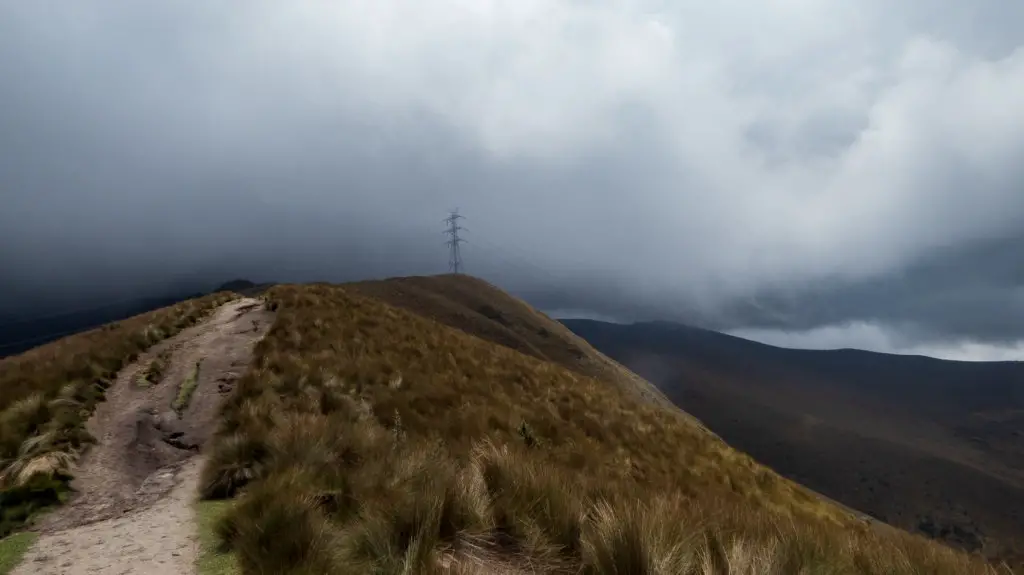
Hiking Rucu Pichincha: The Verdict
So I guess I failed.
Hiking at this altitude is not something to be sniffed at and a hell of a lot harder than most people expect. Despite the stunning views, I was only really able to enjoy them when my lungs weren’t threatening to explode (which they were as soon as I began hiking) or when I wasn’t contemplating a gruesome and painful fall to my death (which I was for the rest of the hike).
Whilst fear played a huge part in my decision to abandon the hike, a much larger contribution was the fact that the trek just wasn’t safe in those conditions. Nothing I read warned me about vertical climbs or the prevalence of snow and sludge on the trail. Combined with the storm that hit shortly after we turned around and the diminishing visibility, it simply wouldn’t have been safe to continue along the narrow ridges of the volcano. Despite my failure, I feel no regrets at having let the hike beat me, just relief that I didn’t become a victim of the almighty Pichincha.
Unless you are both an experienced hiker and climber, I wouldn’t attempt trying to reach the summit of Pichincha unless the conditions are absolutely perfect or you are completely crazy. The trail is demanding and requires a degree of experience, not to mention bravery! Whilst I read numerous accounts of people that made it to the top, they often seemed to rely on the help of more capable co-hikers and downright luck. I’d definitely advise hiring a professional guide and keeping a close eye on the weather if you seriously want to attempt the summit.
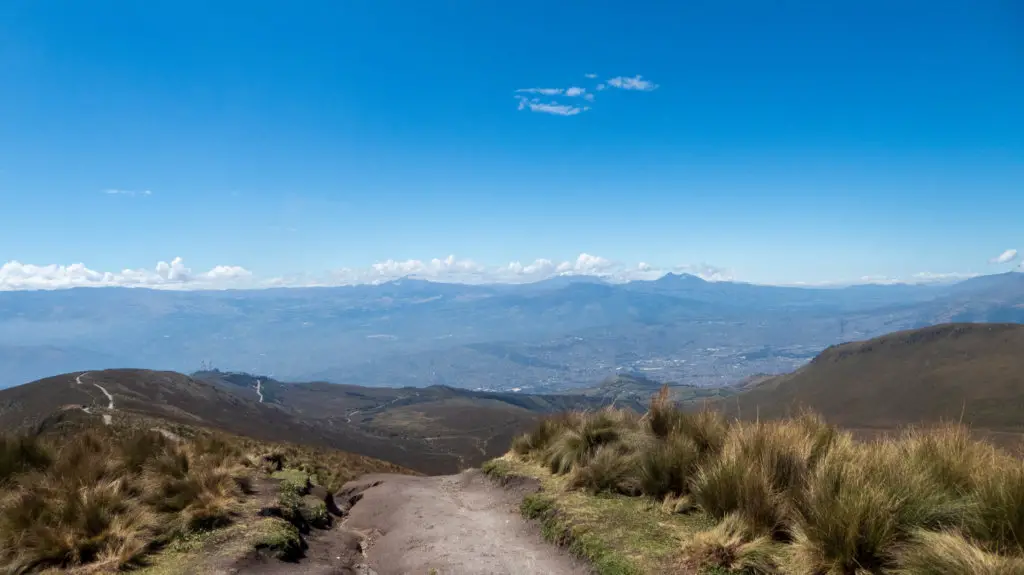
In case you haven’t already guessed, I didn’t enjoy my Pichincha hike. I definitely didn’t give myself enough time to adapt to the altitude naturally which made the whole journey arduous and exhausting. If I wasn’t doomed from the start because of this, the weather definitely eradicated any chance I had of reaching the summit. However, despite the failure on my first attempt, I would be keen to meet Pichincha for round two, (probably with a guide next time).
My main advice to others wanting to tackle the Rucu Pichincha hike would be to consider their own safety. Hiking to the top of an active volcano definitely sounds cool but it is not worth risking your own neck in bad weather to get there. A badge of honour is no good if you’re dead after all!
Have you ever hiked Rucu Pichincha?
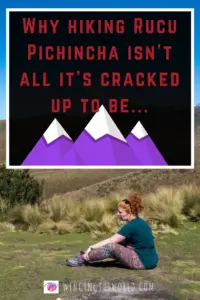
Love it? Pin it! 🙂

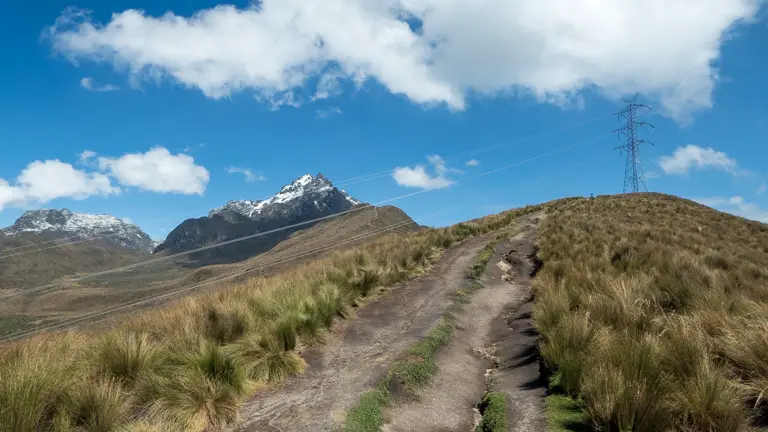
I feel you 100% on this one. Well, kind of. I’m funny in that hiking in altitude is actually a little easier for me than most people because I grew up in the mountains. HOWEVER, when we hiked the Tiger’s Nest in Bhutan, I thought I was going to die. I WAS massively out of shape and overweight when we did it, but it was so much harder than any other high altitude hike I’d ever done. Every step I thought I was going to collapse. When we finally made it to the top (after descending and then once again ascending what felt like a million steps), there are, it turns out EVEN MORE steps. And that’s pretty much when I had a breakdown. Of course, you’ll get none of this on our blog because Jeremy wanted to write the Tiger’s Nest article. He still talks about struggling, because we definitely both were, and he had a much harder time with the altitude than I did. Nevertheless, despite my saying it was totally fine, he didn’t want to paint me in a bad light and left out my meltdown.
So I failed, as well. I hiked all the way up to the top of the Tiger’s Nest, but I just couldn’t muster the strength to climb the last few flights of stairs. And so technically I haven’t actually seen it…
Pichincha looks stunning, but given our track record… we’ll likely have to give it a pass! Glad you made it out alive!
Oh gosh! I feel you. I think that hiking at altitude is often scoffed at but you really don’t know how challenging it is until you try it. Your experience sounds horrendous but I can’t help but feel relieved that it’s not just me! I think growing up in the mountains surely helps a little but not much if you’ve moved about lived in flatter places since then. My Norfolk roots definitely didn’t aid me in this trek!
Hi Sheree. My daughter and I hiked Rucu in 2019. Didn’t reached the summit as the weather was turning bad. We reached la Cueva del Oso then turned back. We did the hike with four days of acclimatation. Yes, we had to stop many times to catch our breath. The next day we hiked Cotopaxi. We reached a little over 5000 meters. It was snowing and very windy. Which made the hike treacherous. Our goal was to reach the glaciers. We didn’t accomplished that. We had a wonderful guide for this hike. On my next trip to Ecuador, I’m planning to hike Chimborazo and try my luck reaching 5300mtrs=17000 ft. We finally hiked a glacier in Alaska this year. We’re very happy with our accomplishment. Take care! Stay well.
I never did Cotopaxi while I was in Ecuador, would love to try it now with a better idea of what to expect. Good luck with your Chimborazo journey! I hope everything goes well for you 🙂
Hi. I did the trail up to Pichincha back in October 2010. I’d already been in Quito for 5 days so had just got used to being at 3000m. The cable car was great. The windows suddenly misted up about half way up but I guess that’s the altitude. I arrived at the top of the cable car route early afternoon. I hadn’t read the advice about going in the morning but the weather was good and I thought a few hours should be okay. I followed some signs and just kept going. The scenery was like a lot of mountains I had walked up but the views were amazing. Also, I had assumed Ecuador being on the equator would be hot but of course, Quito at around 3000m altitude was like British weather in April. Up where I was now was even cooler at about 8 or 9 degrees. Anyway, I carried on walking slowly and monitored the altitude on my gps. After about an hour I had got to around 4200m and I was starting to get tired. Although 40 years old, I was still quite fit and so it was very strange for me to feel this tired and had to stop for a minute. Then I would walk another 50m and have to stop again. I eventually got to 4330m and that was all I could do. By now, the stop breaks were happening more often. It started to snow! Snow on the equator – a magic experience! I would have gone on a bit more but just as you reported in your blog, I heard thunder. The clouds quickly rolled in and I thought ‘where’s the worst place to be in a thunderstorm?’ Oh yes, up the top of a mountain with no shelter! I got scared, turned and started to jog all the way back to the cable car. I managed to do this as it didn’t take much energy I just let gravity carry me down and I think it only took about 40 mins to get back. But what an experience. I had a beer at the bar at the top, poured it into my glass and it fizzed out all over my trousers. I felt drunk on half a pint. I got the cable car back down just before they closed and it was dark when I got to the bottom. In hindsight, I should have started a few hours earlier but the truth is I didn’t have time. I still managed to get a few good hours in though. Also, it would probably have been better to go with someone or a group next time. I didn’t see a single person from when I left the cable car to when I had that drink. So that loneliness perhaps added to the adventure. Looking back years later I am so glad I did what I did. To walk at over 4000m is so amazing. I hope I get to do something like this again. All the best.
Thanks for sharing your story Stu! I’d love to get back to Pichincha and try this hike again – hopefully with more success the next time around!
Interesting story. We were in Quito in April 2019 and then went to Cotopaxi. There you can drive pretty far up the mountain-to around 15,000 ft. But once I started hiking the altitude hit me pretty hard. It was also very windy. I didn’t make it very far. Good luck!
Ps-we were lucky to climb to the Tigers Nest in 2010. Scary stairs near the top, but we survived the altitude and the weather in May was fine. Great country to explore.
Thanks so much for your comment Arthur! Wow, the Tiger’s Nest is one that I would love to do. I’d definitely make sure to leave allow time to acclimatise before tackling that!
Hello! I’m in Quito in December for a bird research project I’m volunteering on in Mindo. I’m a keen hiker and wanting to go up the volcano, and have done 1 high altitude mountain hike before.
However
I will be there alone, and am a woman… did you do this alone or with your partner? Would you say it’s not safe to do alone?
I’d love the sense of achievement but this talk of robbery is scaring me. I’d also want to take my camera but if it got stolen… would you just blank recommend a guide no question?
Thanks
J
Hi Jess! Thanks for your question.
I did this with my partner. At the time as there were lots of warnings floating around about doing it on your own. Muggings and robberies were common and criminals had been known to specifically target solo travellers on the hike. However, that situation may have changed. I’d advise having a chat with some of the locals and seeing what they recommend. However, for peace of mind, a guide is probably the best option.